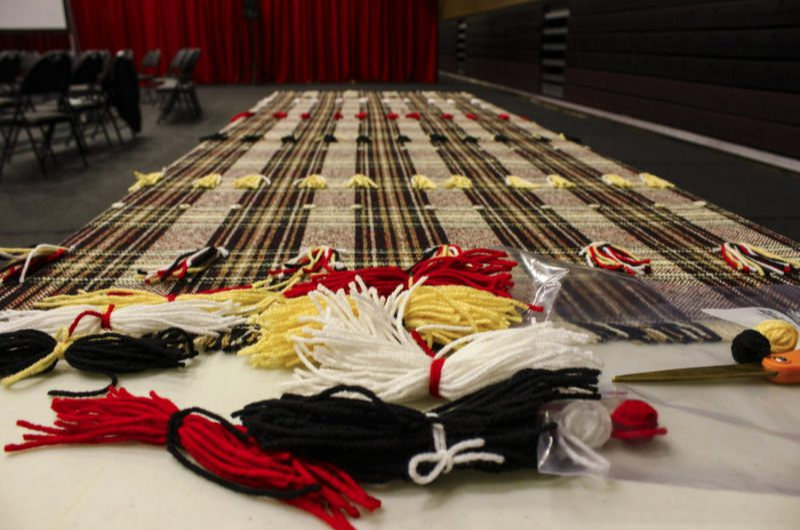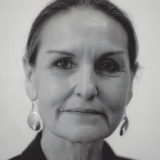 'Reconcilliation Blanket' collaboration lead by Louise
'Reconcilliation Blanket' collaboration lead by Louise
Profeit-Leblanc at the PC/Cp Gathering 2017 on Lekwungen
territory. Photo credit: Naomi Kennedy.
In September of 2017, I was honoured to be invited to to share a storytelling space with Chilean storyteller, Lina de Guervera, at the Primary Colours/Couleurs primaires Gathering, which resulted in future plans for a potential collaboration with her and her colleagues, in Victoria.
This symposium consisted of many talented artists from all backgrounds and practices, and was held on Lekwungen Territory near Victoria. From the beginning to the end, the Songees showered us with their loving hospitality.
I was pleased that Primary Colours/Couleurs primaires recognized the universality and importance of having story as the foundation of all that we do, as artists. Many stories were shared throughout the symposium including during the meals and break, which allowed us to get to know our brothers and sisters from all of the four directions. We also had ample time and inspiration from panel discussions to catch this multitude of reflections, from all these diverse practices.
I chose a “teaching” story from my homeland, the Yukon. The story was passed on to me by my great Auntie Mary Vittrekwa, a Takudh Gwichin from Arctic Red River, NWT, a people who have been, and continue to be, dependent upon the Porcupine Caribou herd as part of their life subsistence.
The genesis of this story is about caribou migration. It takes place at a time when the herd had taken another migratory path, leaving the people in a state of starvation. The protagonist in this precious story is a young boy, from the moon, who by singing a medicine song and dancing was able to draw the caribou back to save his people from perishing. The hunters of the settlement unfortunately prove to be untrustworthy and don’t keep their promise to pay the boy the delicacy of caribou stomach fat he had been promised. This boy had no alternative but to return to the moon, yet he continues still today to move caribou herds from their summer to winter homes, at the full moon of autumn and spring. I encouraged my audience to watch for these two distinct moons, where they will see a boy holding onto some caribou stomach fat!
A storyteller usually has an initial challenge of creating a suitable environment within the performance space they have been given. It has to be comfortable to both listener and teller and the audience has to be able to see and hear the storyteller clearly. In the classroom provided, I instructed my audience to envision a campfire burning in the centre, thus becoming a beautiful sharing circle of listeners! After turning down the lights and instructing them to turn off their phones, the space was readied. It became a place where story could come to life, where people’s imaginations could be sparked! In that darkened space, we journeyed back in time, transported onto a northern land mass where the Porcupine Caribou herd have migrated for thousands of years, between the Yukon and Alaska.
Traditional stories are the true wealth of a people as well as for their descendants and people who live here now. They reflect the strength and endurance of people who lived on the land and play a significant role in reminding us all of our own sense of spirituality and how to respect our environment today.
It was revealing to me to discover how many people had never been exposed to traditional Indigenous storytelling, so to wrap up the session, I asked: “What did this story mean to you? How does it impact you in your own day to day life?” It was refreshing to hear the common responses despite the cultural differences. The spirit of story had done its job!

Louise Profeit-Leblanc is an internationally renowned, traditional Storyteller from the Nacho Nyak Dun First Nation of Mayo, in northeast Yukon. For well over 35 years she has been committed to the cultural and artistic heritage of Yukon First Nations people. Prior to her move to Ottawa where she served as the Aboriginal Arts Coordinator for the Canada Council for the Arts for 11 years, she was employed by the Heritage Branch of the Yukon Government. It was during this tenure that she was introduced to the traditional stories of the Yukon, which ultimately inspired the founding of the Yukon International Storytelling Festival and the Society of Yukon Artists of Native Ancestry, both germane to the evolution of public presentation of Yukon First Nation cultural practices that we see flourishing in the Yukon today. Her association with many Yukon Elders resulted in her role as a “Story Keeper,” a responsibility and honour which she does not take lightly being constantly reminded by the wise words of her mentor/teacher, Tagish Elder, Angela Sidney-“Live your life like a story!”; a practice she attempts to uphold throughout her everyday life. She has a strong belief that through this process of sharing stories, humanity will right itself and come to a better understanding about the “sacred space” of reconciliation.